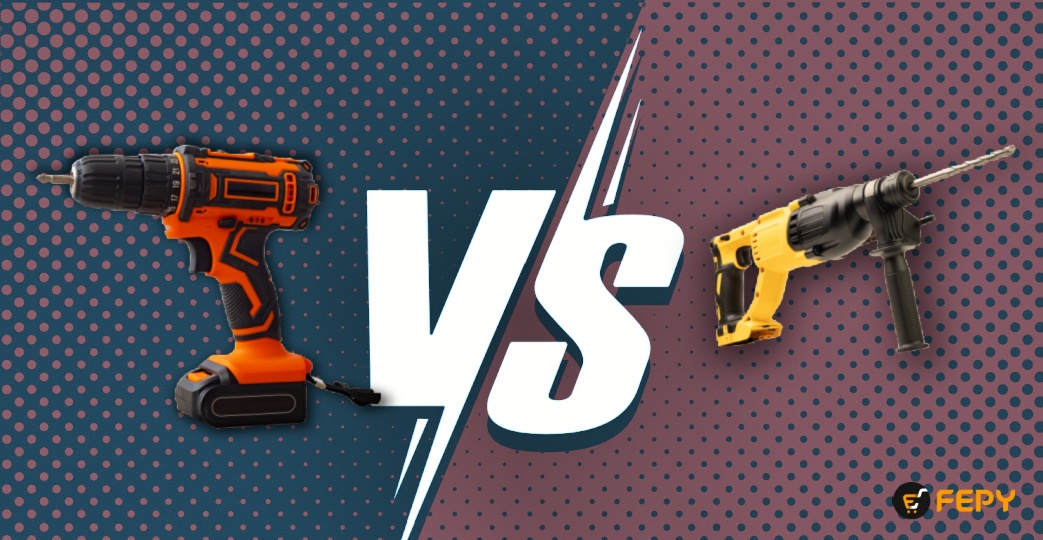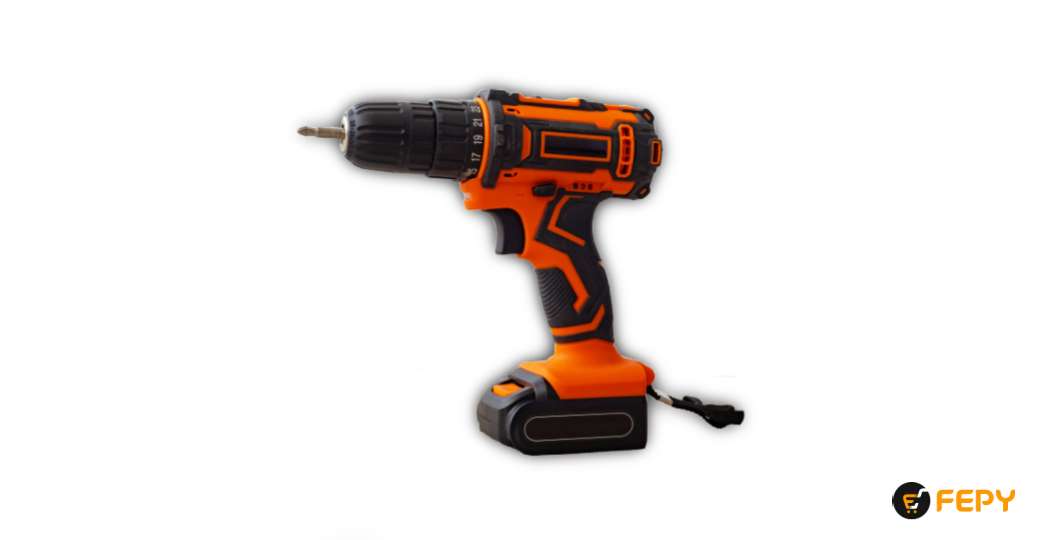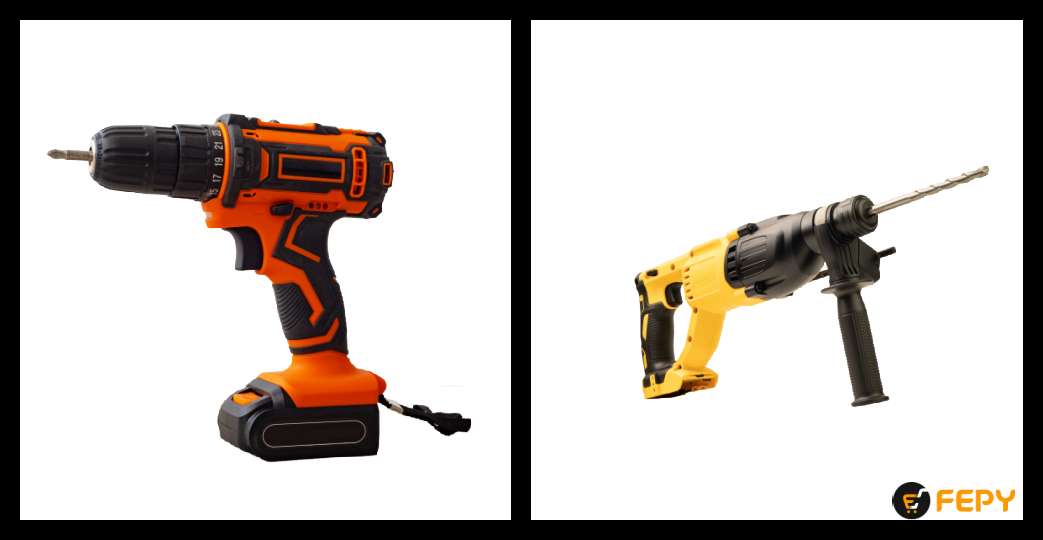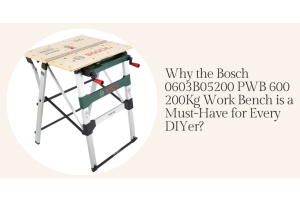Hammer Drill vs. Impact Drill: Which Should You Choose?

Drilling into tough materials requires specialised tools. Hammer and impact drills can tackle the challenge and offer distinct advantages. Understanding their roles is key to mastering your projects. Let's explore their differences and strengths to help you decide which powerhouse suits your needs best.
Hammer Drill vs. Impact Drill: 10 Factors to Consider
When choosing between these tools, consider these 10 crucial aspects. They'll guide you to the ideal solution for your work:
1. Purpose:
Hammer Drill:
This tool delivers drilling and hammering action, perfect for conquering concrete, brick, and masonry. Think electrical work, installing anchors, and even light demolition.
Impact Driver:
Built for speed and power, this masterfully drives and removes screws, bolts, and other fasteners. It conquers wood, metal, and other tough surfaces but isn't suited for drilling holes.
Key Point:
Choose a hammer drill to pierce tough masonry, and reach for an impact driver to tackle fasteners effortlessly.
2. Applications:
Hammer Drill

Use a hammer drill to cut through concrete, brick, and stone. By combining drilling and hammering forces, it can break through materials that other drills would not be able to break.
Consider installing anchors, running electrical wiring, or light demolition. This is a heavy-duty tool for pros and those tackling challenging materials.
Impact Drive
An impact driver is built for driving and removing screws, bolts, and fasteners with blazing speed.
Its powerful rotational bursts and hammering action help drive fasteners into wood, metal, and more without stripping them.
Perfect for jobs like deck building, furniture assembly, or automotive work. It's a favourite for saving time and frustration for DIYers and semi-pros alike.
Key Point:
Dealing with dense materials? The hammer drill is your powerhouse. Focused on fasteners? The impact driver brings speed and precision. Pick the tool that aligns with your project's demands.
3. Mechanism:
Hammer Drill
A drill is tipped with two toothed gears that lock and unlock rapidly. The rotating mechanism creates a relentless hammering force.
This forceful pounding helps the drill bit chip away at tough materials like concrete. A hammer drill's power is often measured in blows per minute (BPM), with many reaching tens of thousands!
Impact Driver
Tiny hammers inside repeatedly compress the spring, and the anvil slams against it repeatedly. This generates a burst of rotational force, or torque, that twists with incredible power.
An impact driver's strength is measured in impacts per minute (IPM) or blows per minute (BPM), often reaching several thousand.
Key Point:
A hammer drill chips with a rapid hammering motion alongside drilling. An impact driver delivers powerful twisting blows for driving in fasteners.
4. Weight:
Hammer Drill
Expect a hammer drill to weigh 2 to 5 kilograms. This purposeful heft reflects the power it needs to tackle challenging materials.
You wouldn't bring a feather to a fight, and the hammer drill is not lightweight. It's a tool built for strength, best suited for jobs where raw power is crucial.
Impact Driver
An impact driver is a featherweight compared to a hammer drill, typically in the 1 to 2.5-kilogram range. This lightness translates to comfort.
Need to work in awkward spaces, overhead, or for long stretches? The impact driver minimises fatigue. Its manoeuvrability shines when speed and accuracy matter more than brute force.
Key Point:
The hammer drill packs a heavier punch but sacrifices some comfort. The impact driver is far more manoeuvrable, ideal when ease of use is as important as power.
5. Size:
Hammer Drill
The hammer drill requires a powerful motor and complex hammering mechanism to punch through tough materials. This means a larger build overall.
Common sizes range from 1/4 to 1 inch in diameter, with 1/2 and 3/4 inch being the most popular. The hammer drill works best when you have room to manoeuvre it.
Impact Driver

The impact driver focuses on driving fasteners, meaning a smaller, lighter design is possible. It's built to fit into tighter spaces without sacrificing power.
You'll see the same size range as the hammer drill (1/4 to 1 inch), with 1/2 and 3/8 inch being the most used.
Key Point:
The hammer drill's larger design is necessary for its heavy-duty jobs. The impact driver's smaller size makes it ideal for tight spaces and tasks where manoeuvrability matters. Consider your workspace and drill bit sizes when making your choice.
6. Drill Bits:
Hammer Drill
Hammer drills conquer concrete with specialised masonry bits, often called SDS-Plus or SDS-Max.
These have tough carbide tips to handle the force and grooves, ensuring a secure grip within the hammering mechanism. Think of them as the "armour-piercing rounds" of drill bits.
Impact Driver
Impact drivers rely on standard HSS twist drill bits to handle various tasks smoothly. While they can drill into harder materials with enough pressure, they shine with metal, brick, tile, and other softer materials.
The impact driver's compatibility is advantageous if you need to drill different materials regularly.
Key Point:
Hammer drills pair with specialised bits for maximum efficiency in hard materials. Impact drivers offer more versatility with standard bits but may need extra force on the toughest surfaces.
7. Torque:
Hammer Drill
A hammer drill focuses on breaking through tough materials with its rapid-fire hammering action.
While still powerful, it sacrifices some twisting force compared to its cousin. Think less about driving screws and more about creating clean holes.
Impact Driver
This tool is all about twisting with immense force. Its hammer-and-anvil design unleashes bursts of rotational power, perfect for driving large screws and bolts effortlessly. If a fastener won't budge, the impact driver is your solution.
Key Point:
A hammer drill might top out at 18 Nm of torque, while an impact driver can reach 40 Nm or higher. That's the difference between driving a standard screw and sinking a hefty lag bolt.
Impact drivers deliver massive torque for fastening tasks. Hammer drills prioritise drilling power, especially in the toughest materials.
8. Speed:
Hammer Drill
A hammer drill isn't built for a sprint but for consistent, relentless work. Its top speed is often around 1,900-2,100 RPM. A constant force combined with the hammering action breaks through concrete, going slowly.
Impact Driver
Speed is the name of the game for the impact driver. It can reach upwards of 3,000 RPM for swift, effortless driving of fasteners. The lower impact force than a hammer drill allows for this faster spin, perfect for jobs where time is money.
Key Point:
The hammer drill sacrifices some speed for its concrete-crushing power. The impact driver provides high RPM for rapid fastening tasks. Depending on your project, you will need to determine which type of speed is most important.
9. Noise Level
Hammer Drill
The hammering action used to break through concrete creates intense noise. While specific decibel levels (dBA) can vary, expect it to be hard on your ears.
Impact Driver
While also noisy, its short, sharp bursts of sound have a different quality than a hammer drill. Some people find this noise slightly less damaging, though hearing protection is still necessary.
Key Point:
These tools are LOUD. That's why hearing protection is essential on any job site. Always prioritise ear protection, no matter which you choose. The specific material you're working with and the drill model will also affect the noise levels.
10. Cost:
Hammer Drill
The added power and specialised hammering mechanism necessary for tough materials come at a cost.
Expect hammer drills to be more expensive, especially cordless models. Those require powerful batteries, driving the price even higher.
Impact Driver
Focused more on driving fasteners, the impact driver has a simpler design and generally a lower price tag. This makes it a favourite for DIYers and buyers who prioritise value.
Key Point:
In the UAE, hammer drills, particularly brushless cordless models, often cost more. If you're budget-conscious, an impact driver might be the right starting point. Your project needs and budget should guide your final decision.
Hammer Drill vs. Impact Drill: Comparison Table

| Parameter | Hammer Drill |
Impact Driver |
| Purpose |
Drilling into hard materials like concrete, brick, and masonry. Also suitable for light demolition work. |
Driving and removing screws, bolts, and other fasteners with speed and efficiency. |
| Applications | Installing anchors, running electrical wiring, drilling holes in concrete for plumbing, and small-scale demolition. |
Deck building, furniture assembly, automotive work, and tasks involving driving fasteners into wood, metal, and other materials. |
| Mechanism | Uses a rapid hammering action along with rotational drilling force. |
Delivers powerful bursts of rotational force (torque) along with a brief hammering motion. |
| Weight | Heavier (2-5 kg) due to the complex hammering mechanism. |
Lighter (1-2.5 kg) for better manoeuvrability and comfort during extended use. |
| Size | Larger overall due to its robust motor and hammering components. |
More compact and easier to handle in tight places. |
| Drill Bits | Compatible with specialised masonry bits (SDS-Plus, SDS-Max) for optimal performance in hard materials. |
Works with standard HSS twist drill bits for versatility across various materials. |
| Torque | Lower torque output compared to impact drivers. |
Delivers significantly higher torque for driving large screws and lag bolts. |
| Speed | Lower rotational speed (around 1,900-2,100 RPM) prioritising power over speed. |
Higher rotational speed (up to 3,000 RPM or more) for fast and efficient fastening. |
| Noise Level |
Produces extremely loud noise due to the intense hammering action. |
Generates loud, high-pitched bursts of noise. Hearing protection is essential for both. |
| Cost | Generally more expensive, especially cordless models and those with brushless motors. |
More affordable, especially for DIYers and budget-conscious buyers. |
FAQs
Q. Can a hammer drill be used as an impact driver?
Technically, it could be more comfortable due to the size and weight of most hammer drills. If you primarily drive screws, invest in a dedicated impact driver.
Q. What is the key difference in power specifications between hammer drills and impact drivers?
Hammer drills are rated in blows per minute (BPM) and impact energy. Impact drivers shine in terms of torque (measured in inch-pounds or Newton metres).
Q. How do the size and weight of hammer drills and impact drivers differ?
Hammer drills are usually bulkier and heavier due to their hammering mechanisms. This matters when working for long stretches or in tight spaces.
Q. Can an impact driver be used for drilling holes?
It's possible in softer materials, but not ideal. Its design focuses on driving fasteners rather than smooth drilling. For versatility, a standard drill is a useful addition.
Q. Which tool is better for DIY projects vs. professional use?
DIY enthusiasts will love an impact driver's versatility and ease of use. Pros tackling heavy-duty jobs every day will need the specialised power of a hammer drill.
Final Words
Understanding the differences between a hammer drill and an impact driver empowers you to choose the best tool for your job. Consider your project needs, budget, and whether ease of use is a major factor.
Ready to upgrade your toolbox? Explore FEPY for a wide selection of high-quality hammer and impact drills. FEPY is the UAE's leading e-commerce store for construction tools and materials.
Find the perfect tool for your next project at FEPY and experience the power these tools can bring to your work.







